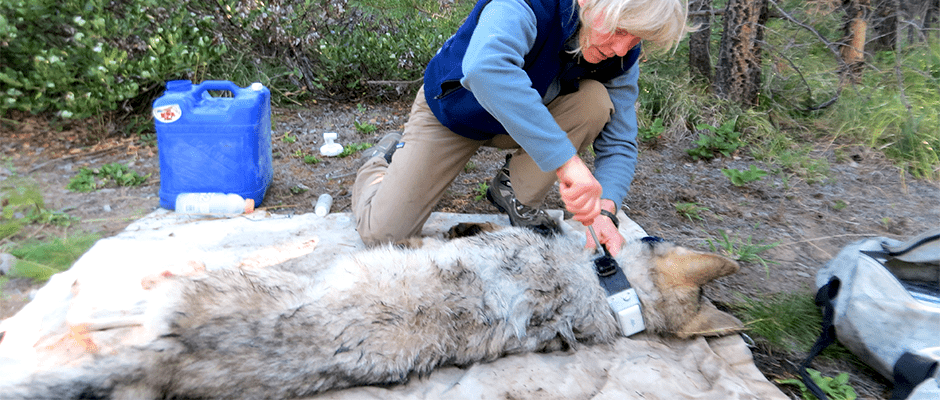Share this article
JWM study: Dispersal spreads wolves throughout the West
When Diane Boyd arrived in Montana in 1979, the northern Rockies had just one wolf. A lone female wolf, it had wandered from Canada, possibly from as far as Banff National Park, some 250 miles to the north. Researchers nicknamed her Kishinena, for the Canadian creek that flowed just across the border from Glacier National Park.
“I believe she was the only wolf outside Minnesota in the Lower 48,” said Boyd, who herself had dispersed from her native Minnesota to live in a remote cabin in the North Fork of the Flathead River valley. A University of Montana graduate student, she had come to study with her professor, Bob Ream, who had heard enough reports of gray wolf (Canis lupus) sightings to launch the Wolf Ecology Project six years earlier.
Boyd had come to trap and collar wolves, but it was only coyotes that ended up in her traps.
“There weren’t any other wolves,” she said. “And then another wolf appeared.”
In the fall of 1981, a male wolf arrived, leaving tracks that showed just three toes on one front paw, a hint that it had been caught in a trap and escaped. By then, the tracking collar that Kishinena wore had failed, but Boyd believed she was still around. Sign of a female wolf was seen in her home range. Boyd believed it was Kishinena. The two wolves mated and had a litter of seven pups in 1982.
In June, when the pups were two months old, the male died, but Boyd and Ream followed eight wolf tracks across the landscape. “That was just phenomenal that they survived with only their mother provisioning them,” she said.
Today, more than 1,700 wolves roam the northern Rocky Mountains, thanks to Montana’s naturally recolonizing wolves from Canada, followed by a reintroduction program that brought 66 gray wolves to Yellowstone National Park and central Idaho during the winters of 1995-96 and 1996-97. The species’ recovery is also thanks to wolves’ ability to disperse and survive, Boyd said.
“Biologically, their reintroduction has been the wildest, greatest success story of any endangered species I can think of,” said Boyd, a TWS member and now the wolf and carnivore specialist for Montana Fish, Wildlife and Parks’ Region 1. She is a co-author on a recent paper published in the Journal of Wildlife Management that documents wolf dispersal in the northern Rockies from 1993 to 2008.
When the study began, 55 known wolves lived in the northern Rockies, all the result of a handful of dispersers from Canada and subsequent successful reproduction in Montana. By the end of the study, researchers counted at least 1,655 wolves and noted a high genetic diversity in their populations.
“That’s the biggest take-home message for me,” Boyd said. “Inbreeding is not a concern anymore. Essentially, now all the wolves are linked all up and down the Rocky Mountains. They’re genetically safe.”
The study described dispersal behavior as “innate in sexually mature wolves.” It found that male wolves were somewhat more likely to disperse, but female dispersers were more likely to reproduce. The mean age of dispersing wolves was 32 months. They traveled a mean straight-line distance of 98.1 kilometers for male wolves and 87.7 kilometers for female wolves, although the actual distance traveled could be much farther. Only 10 wolves, or 3.4 percent of those observed, traveled more than 300 straight-line kilometers.
Wolves are capable of crossing much greater distances, Boyd said, but their lives are usually cut short. The study found that 80 percent of wolf mortality was caused by humans. Little else seems to stop them.
“Only extremely large bodies of water or deserts appear to prevent wolf dispersal,” researchers wrote. “Dispersal is critical to wolf population resilience and has allowed wolves to persist throughout much of their historical range worldwide and to recover in areas where they had been extirpated by human persecution.”
Given time, wolves will likely reoccupy more of their historic range in the West, Boyd said. Packs have appeared in northern California. Lone dispersers have reached Utah and Colorado. One day, she said, a gray wolf from the northern Rockies may reach Colorado, mate with a Mexican wolf from the Southwest and unite long distinct populations.
“Dispersal behavior is just innate in who they are,” Boyd said. “Given the chance, they will recover.”
TWS members can log into the member portal to read this paper in the May issue of The Journal of Wildlife Management. Go to Publications and then The Journal of Wildlife Management.
Header Image: Diane Boyd, wolf and carnivore specialist for Montana Fish, Wildlife and Parks’ Region 1, collars a wolf. Photo courtesy of Diane Boyd.








